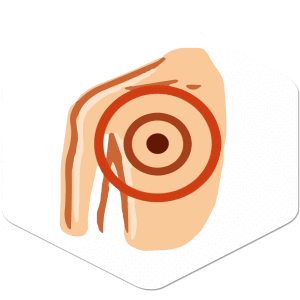Shoulder Pain
 What most people call the shoulder is really several joints that combine with tendons and muscles to allow a wide range of motion in the arm — from scratching your back to throwing the perfect pitch. Mobility has its price, however. It may lead to increasing problems with instability or impingement of the soft tissue or bony structures in your shoulder, resulting in pain. You may feel pain only when you move your shoulder, or all of the time. The shoulder pain may be temporary or it may continue and require medical diagnosis and treatment.
What most people call the shoulder is really several joints that combine with tendons and muscles to allow a wide range of motion in the arm — from scratching your back to throwing the perfect pitch. Mobility has its price, however. It may lead to increasing problems with instability or impingement of the soft tissue or bony structures in your shoulder, resulting in pain. You may feel pain only when you move your shoulder, or all of the time. The shoulder pain may be temporary or it may continue and require medical diagnosis and treatment.
Shoulder Pain Definition:
- Shoulder pain is any pain in or around the shoulder joint. Considerations. The shoulder is the most mobile joint in the human body. A group of four tendons in the shoulder, called the rotator cuff, give the shoulder a wide range of motion.
What has caused my Shoulder Pain?
Most shoulder pain problems fall into four major categories:
- Tendon inflammation (bursitis or tendinitis) or tendon tear
- Instability
- Arthritis
- Fracture (broken bone)
Other much less common causes of shoulder pain are tumors, infection, and nerve-related problems.
Bursitis
Bursae are small, fluid-filled sacs that are located in joints throughout the body, including the shoulder. They act as cushions between bones and the overlying soft tissues, and help reduce friction between the gliding muscles and the bone.
Sometimes, excessive use of the shoulder leads to inflammation and swelling of the bursa between the rotator cuff and part of the shoulder blade known as the acromion. The result is a condition known as subacromial bursitis. Bursitis often occurs in association with rotator cuff tendinitis. The many tissues in the shoulder can become inflamed and painful. Many daily activities, such as combing your hair or getting dressed, may become difficult.
Tendinitis
A tendon is a cord that connects muscle to bone. Most tendinitis is a result of a wearing down of the tendon that occurs slowly over time, much like the wearing process on the sole of a shoe that eventually splits from overuse.
Generally, tendinitis is one of two types:
- Acute. Excessive ball throwing or other overhead activities during work or sport can lead to acute tendinitis.
- Chronic. Degenerative diseases like arthritis or repetitive wear and tear due to age, can lead to chronic tendinitis.
The most commonly affected tendons in the shoulder are the four rotator cuff tendons and one of the biceps tendons. The rotator cuff is made up of four small muscles and their tendons that cover the head of your upper arm bone and keep it in the shoulder socket. Your rotator cuff helps provide shoulder motion and stability.
Tendon Tears
Splitting and tearing of tendons may result from acute injury or degenerative changes in the tendons due to advancing age, long-term overuse and wear and tear, or a sudden injury. These tears may be partial or may completely split the tendon into two pieces. In most cases of complete tears, the tendon is pulled away from its attachment to the bone. Rotator cuff and biceps tendon injuries are among the most common of these injuries.
Impingement
Shoulder impingement occurs when the top of the shoulder blade (acromion) puts pressure on the underlying soft tissues when the arm is lifted away from the body. As the arm is lifted, the acromion rubs, or “impinges” on, the rotator cuff tendons and bursa. This can lead to bursitis and tendinitis, causing pain and limiting movement. Over time, severe impingement can even lead to a rotator cuff tear.
There are many other causes of shoulder pain. Stop living in pain and talk to a doctor at Interventional Pain Associates.
